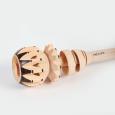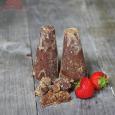
I am currently obsessed with Mexican Atoles. They are perfect for this time of the year as they are warm and nutritious. Giving that Christmas is nearly here, I decided to post what it is perhaps the most traditional and Christmassy of all known Atoles: Champurrado.
Let me start by telling you that an Atole is an ancient, pre-hispanic, Mexican drink made originally by boiling corn-masa (maize dough) until thickened, flavouring it with things like vanilla, chocolate, chili and sweetening it with honey. The word Atole, derives from the Nahuatl word Atolli, which means something close to 'thin' or 'runny', both referring to texture of the drink.
Its original Aztec flavour is believed to have been quite bland to the European palate (the head conquistador Cortez wrote about Atoles to the Spanish Crown in those terms); the drink most likely had an earthy taste from the maize and an almost granular texture from the masa, perhaps too complex for the simple palates of the Spanish soldiers back then. Nontheless, the mentioning of Atoles in the correspondance shows how important they were in the every day life of indigenous Mexicans. They were, if you like, the first energy drink ever to be made in Mexico. It was given to the sick to improve their constitution and to those who did heavy work to help with their strenght (mind you, the same was said about Guinness!).
With time, piloncillo (raw sugar cane) and white sugar replaced the honey, and worst of all, corn starch replaced the masa. By the early 1930's corn startch was introduced to the mass Mexican market and many people in Mexico only know those disgusting flavoured atoles made from a pack, very similar to the ready made custard we get here in Ireland. The tradition of hand made atoles slowly taking a second place and fading away from 'civilized circles. We were sold 'convenince' in a pack and forgot how quick it is to actually make them from scratch! The most important change to Atoles was the introduction of milk as the main ingredient. I grew up with these shitty versions of atoles, so when I went on an Atole discovering mission about 3 years ago, I fell in love with the real thing and I want to share some of my love for them here with you.
So I'm going to start with the most traditional of all: Champurrado, which is a drinking atole flavoured with chocolate. It is drunk as part of a good breakfast or traditionally served with tamales this time of the year. My mam loves it with churros too. It is one of my favourite atoles and although far better if made with fresh nixtamalised masa, this version here using dried masa-harina is very, very tasty and brings us over the hump of that one ingredient we cannot find here in Ireland: Mexian Corn.
Put one litre of water in a heavy bottom pot and put it on the hob at medium high heat. Add the cinnamon, the chocolate tablet and the piloncillo and let it all heat gently stirring frequently to help the chocolate and the piloncillo melt.


.JPG%EF%B9%96itok=0t_-HwBu.jpeg)
Using a sharp knife, cut the vanilla pod open and scrape the sides from inside into the simmering pot. Mix well and add the pinch of salt.


After about 10 minutes, all ingredients would have disolved into the water and you should have a dark-brown syrupy water. Fish the cinnamon sticks out and reduce the heat to low.


Put the masa-harina in a large bowl or jug, take the remaining half litre of water and slowly add it to the masa-harina, mixing well with a fork. This will give an earthy taste to the champurrado, plus it will act as the thickening agent, so you have to make sure no lumps of flour are left in the mixture. You can pass this mixture throw a sieve, but I think life is too short, so I normally just mix the flour really, really well!

.JPG%EF%B9%96itok=ZITh5ya8.jpeg)
Slowly, pour the runny flour mixture into the hot syrup in the pot while mixing vigorously. I use a Mexican Molinillo to do this, which is a traditional chocolate frother. If you don't have one, a whisk would do a similar job, although not as nice a job as the molinillo would do. Keep mixing at low heat, simmering until the mixture has thickened. Make sure no flour lumps are left in the champurrado.



Serve the Champurrado hot. As it cools down, it will thicken more, so keep that in mind. If it gets too thick, dilute it with a little more water. This is a sweet, energizing drink, perfect for a very cold and stormy night. It keeps well in the fridge for a couple of days, but always reheat to thin out before serving. I hope you enjoy it as much as we do.


















